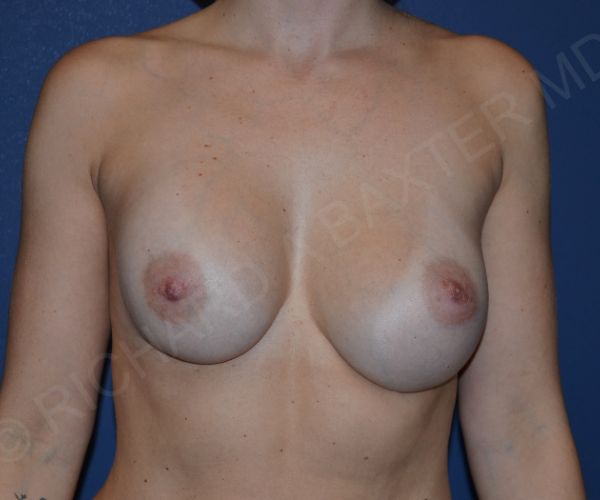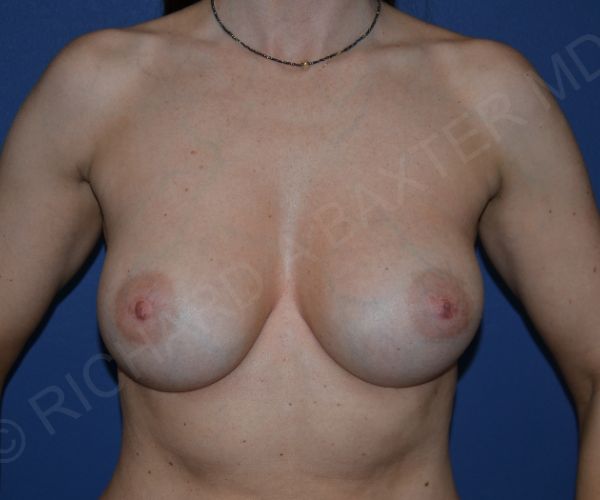

Breast implants remain very popular, and most patients who choose to have them are happy with their decision. But as with all surgical procedures, there are potential problems to be aware of. One of these is a condition called capsular contracture, or “cap con.” Fortunately, this is much less common than it used to be, and we know a lot more about how to prevent it. So, what is capsular contracture?
The capsule is a normal layer of tissue that forms around any implant, whether it be a pacemaker, breast implant, or an artificial joint. A capsule helps keep the implant in place. With breast implants the capsule needs to be strong enough to hold the implant in position over time, but soft enough to allow the implant to compress a little bit so that it feels more like a natural breast.
Capsular contracture is when the capsule gets thick and squeezes the implant, making it feel firm. In extreme cases, it can actually be painful. Fortunately, the chance of developing a contracture at Phase Plastic Surgery is less than 2%, but of course, we would like to get it to zero.
How Can I Tell if I Have a Capsular Contracture?
Capsular contracture is graded according to the Baker scale, with Baker 1 being a breast that feels normal, and Baker 4 being hard and painful. With Baker 2, you will notice firmness of the breast around the implant. Baker 3 is where the implant is more firm and the breast looks noticeably different, with the implant typically displaced upward.
What Causes Capsular Contracture in Seattle, WA?
With cosmetic breast implants (as opposed to implants for reconstruction after mastectomy), most of the time cap con is believed to relate to something called biofilm. Biofilm is an invisible layer created on the surface by normally harmless bacteria. These are bacteria that live in the milk ducts of the breast and on the skin. This is known as your skin microbiome. When they get trapped on the surface of an implant, they try to isolate themselves by forming an invisible biofilm. When your body detects a biofilm, it may start an inflammatory reaction and begin to convert the normal capsule into scar tissue.
How Can Capsular Contracture Be Prevented?
The key to preventing capsular contracture is to prevent any contact of the implant with bacteria and to keep the space as sterile as possible. As with every surgical procedure, we always do an antiseptic skin prep and keep the operating room sanitary. Other things we do to prevent capsular contracture are irrigate the implant space with an antibacterial solution and use a device called a Keller funnel to slide the implant in while avoiding contact with skin and breast tissue. We published a clinical study a few years ago that showed that the funnel reduced capsular contracture.
One thing that doesn’t work to prevent capsular contracture is implant massage. Although some plastic surgeons still recommend it, there is no good evidence that it makes a difference in capsular contracture occurrence.
Treatment of Breast Implant Capsular Contracture in Seattle, WA
Once a contracture occurs, it can be difficult to treat. There is a medication called Singulair (Montelukast), which is actually an asthma medication, that works on the specific inflammatory process thought to be involved in capsular contracture (and asthma). It is often used for prophylaxis and a first-line treatment for early cases of contracture.
Most often, however, the treatment involves surgery and replacement of the implant. At Phase Plastic Surgery, we also do a procedure called capsulectomy, which is the surgical removal of the capsule.
In cases that recur or are particularly severe, we place a material called Strattice, which is a type of Acellular Dermal Matrix or ADM. The Strattice serves 2 functions:
- First, it adds back the support and implant coverage that was lost with the capsulectomy. Think of it as an internal bra for the implant.
- Second, it is highly effective at preventing the capsular contracture from recurring.
The disadvantages of Strattice ADM are expense and recovery time. For patients with recurrent capsular contracture, however, it is well worth it. We have highlighted a case in our before and after photos portfolio to highlight the results that are possible with a capsulectomy and the use of Strattice.
As disheartening, and sometimes painful, as it can be to deal with capsular contracture, our board-certified plastic surgeons are experts in revision breast surgery and treating capsular contracture so that you can reclaim your self-confidence.
Bottom line? Capsular contracture is something that no one wants to talk about, but it can’t be ignored. If you have any concerns that you may be experiencing capsular contracture, don’t hesitate to schedule a consultation with one of our board-certified plastic surgeons in the greater Seattle, WA area.



